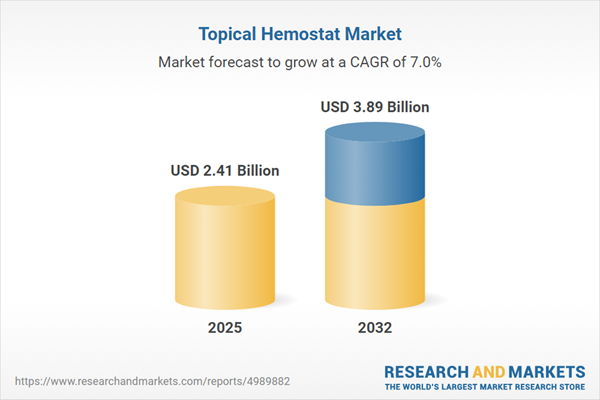Speak directly to the analyst to clarify any post sales queries you may have.
The topical hemostat market is undergoing significant evolution in response to changes in surgical techniques, healthcare infrastructure, and institutional procurement demands. For senior decision-makers, timely understanding of these shifts is critical to seize emerging opportunities and ensure robust positioning in an environment where high-performing hemostatic agents are rapidly becoming standard.
Market Snapshot: Topical Hemostat Market Growth and Trends
The topical hemostat market expanded from USD 2.26 billion in 2024 to USD 2.41 billion in 2025 and is projected to achieve a compound annual growth rate (CAGR) of 7.02%, reaching USD 3.89 billion by 2032. Sustained market momentum reflects a growing emphasis on safe, efficient surgical interventions and the need for advanced hemostatic solutions across healthcare sectors. Greater procedural complexity and an ongoing drive for improved patient outcomes have contributed to the rapid integration of innovative hemostatic agents in both established and emerging markets. Healthcare providers are increasingly seeking products that streamline operating room efficiency, bolster clinical standards, and support adaptability across diverse surgical disciplines.
Scope & Segmentation of the Topical Hemostat Market
- Product Types: Choices include collagen, cyanoacrylate, gelatin, oxidized regenerated cellulose (fabric and powder), and thrombin-based solutions. Each type is optimized for specific biocompatibility, sealing speed, or cost-effectiveness according to procedural requirements and clinical preferences.
- Applications: Utilization spans cardiovascular operations (such as bypass and valve surgery), general surgical procedures (both laparoscopic and open), neurosurgical cases for all age groups, orthopedic surgeries (joint and spine), and specialized dental interventions (including extractions and restorations).
- End Users: The market serves ambulatory surgery centers, multi-specialty and orthopedic clinics, public and private hospitals, and dedicated specialty facilities focused on cardiac and neurological care.
- Distribution Channels: Institutional buyers can obtain products through direct field sales, tele-sales, national and local distribution networks, inpatient and outpatient hospital pharmacies, and institutional or third-party online platforms.
- Geographical Coverage: Coverage incorporates the Americas (including the United States, Canada, Mexico, Brazil, Argentina, Chile, Colombia, Peru), Europe (both Western and Eastern regions), Middle East (such as the United Arab Emirates, Saudi Arabia, Qatar, Turkey, Israel), key African countries (South Africa, Nigeria, Egypt, Kenya), and Asia-Pacific (focusing on China, India, Japan, Australia, South Korea, Indonesia, Thailand, Malaysia, Singapore, and Taiwan).
- Leading Companies: Market innovation and product breadth are advanced by entities such as Johnson & Johnson Services, Baxter International, B. Braun Melsungen, Medtronic, Medline Industries, Takeda Pharmaceutical, Integra LifeSciences, Dilon Technologies, Pfizer, and Teleflex.
Key Takeaways for Strategic Leadership
- Preference for topical hemostatic agents aligns with escalating demand for expedited, consistent hemostasis in both minimally invasive and open surgical environments.
- Recent advancements in biomaterial science, coupled with digital integration, are enabling more streamlined operative workflows and delivering differentiated clinical value—particularly as robotic and digitally supported surgeries expand.
- The selection of specific product types reflects varying goals: collagen offers compatibility, cyanoacrylates deliver rapid action, and gelatin provides an affordable profile, underlining the importance of tailored sourcing strategies for optimal clinical and financial outcomes.
- Collaborative partnerships between manufacturers and research organizations are accelerating product validation cycles and supporting introduction into new procedural segments, such as those involving robotic-assisted surgery.
- Diversified channel strategies, including direct and digital routes, enhance access to products and support close alignment with institutional and ambulatory operational models.
- Adoption trends are influenced by reimbursement policies, regulatory shifts, and infrastructure investments, driving the need for locally adaptive go-to-market and pricing strategies.
Tariff Impact and Supply Chain Adaptations
Recent U.S. trade policy changes, specifically higher tariffs on medical-grade raw materials, have led to increased procurement costs for topical hemostat manufacturers. In response, organizations are emphasizing domestic and near-shore sourcing, exploring vertical integration in manufacturing, and negotiating long-term supplier contracts to maintain pricing stability and reduce cost volatility. This adaptive procurement and production approach is proving vital to preserving competitive advantage and supply chain reliability.
Methodology & Data Sources
This assessment integrates primary research, including interviews with surgeons, clinical pharmacologists, and procurement professionals, with trusted secondary sources such as journals, regulatory filings, industry publications, and public company disclosures. Data validation relied on triangulation and independent analyst review, ensuring accuracy and objectivity.
Why This Report Matters for the Topical Hemostat Market
- Delivers tailored insights to support senior leaders targeting sustainable growth, operational resilience, and ongoing innovation in evolving surgical markets.
- Facilitates benchmarking with industry competitors, empowering strategy formation around product portfolios, channel development, and geographic expansion.
- Provides a framework for risk management and agile planning amid regulatory and economic uncertainty and ongoing advancements in surgical technology.
Conclusion
This report empowers leaders to refine strategy, optimize value, and proactively adapt in the topical hemostat sector, enabling confident navigation of a dynamic industry landscape.
Additional Product Information:
- Purchase of this report includes 1 year online access with quarterly updates.
- This report can be updated on request. Please contact our Customer Experience team using the Ask a Question widget on our website.
Table of Contents
3. Executive Summary
4. Market Overview
7. Cumulative Impact of Artificial Intelligence 2025
List of Figures
Samples

LOADING...
Companies Mentioned
The key companies profiled in this Topical Hemostat market report include:- Johnson & Johnson Services, Inc.
- Baxter International Inc.
- B. Braun Melsungen AG
- Medtronic plc
- Medline Industries, LP
- Takeda Pharmaceutical Company Limited
- Integra LifeSciences Corporation
- Dilon Technologies Inc
- Pfizer Inc.
- Teleflex Incorporated
Table Information
| Report Attribute | Details |
|---|---|
| No. of Pages | 198 |
| Published | October 2025 |
| Forecast Period | 2025 - 2032 |
| Estimated Market Value ( USD | $ 2.41 Billion |
| Forecasted Market Value ( USD | $ 3.89 Billion |
| Compound Annual Growth Rate | 7.0% |
| Regions Covered | Global |
| No. of Companies Mentioned | 11 |









